Find more information in the General Comments section of the assessment
Find more information in the Rating Validity tab of the assessment
- See More
- See More
- See More
- See More
- Good
- Adequate
- Marginal
- Weak
- Poor
 Passenger
Passenger
 Driver
Driver
 Rear Passenger
Rear Passenger
 Driver
Driver
 Car
Car
 Pole
Pole
 Rear Seat
Rear Seat
 Front Seat
Front Seat
- Good
- Adequate
- Marginal
- Weak
- Poor


Passenger
outboard
center
Fitted to the vehicle as standard
Not fitted to the test vehicle but available as option
Not Available
-
Infants up to 13 kg
-
Infants and toddlers up to 18 kg
-
Toddlers from 9 to 18 kg
-
Toddlers over 18 kg
Easy
Difficult
Safety critical
Not allowed
| Seat Position | ||||
|---|---|---|---|---|
| Front | 2nd row | |||
| Passenger | Left | center | Right | |
| Maxi Cosi Cabriofix (Belt) | ||||
| Britax Römer King Plus (Belt) | ||||
| Britax Römer Duo Plus (ISOFIX) | ||||
| Britax Römer KidFix (Belt) | ||||
| Maxi Cosi Cabriofix & EasyFix (Belt) | ||||
| Maxi Cosi Cabriofix & EasyFix (ISOFIX) | ||||
| BeSafe iZi Kid X3 ISOfix (ISOFIX) | ||||
| Maxi Cosi Pearl & Familyfix (ISOFIX) | ||||
| Britax Römer KidFix (ISOFIX) | ||||
Easy
Difficult
Safety critical
Not allowed
The Astra scored full points for its protection of the 1½ year dummy in the full scale crash tests. Forward movement of the 3 year dummy, sat in a forward-facing restraint, was not excessive and protection was good apart from marginally raised neck tensile forces. In the side barrier test, both dummies were properly contained within the protective shells of their restraints, minimising the risk of contact with parts of the vehicle interior. The front passenger airbag can be disabled to allow a rearward-facing child restraint to be used in that seating position. Clear information is provided to the driver about the status of the airbag and the system was rewarded. All of the restraint types for which the Astra is designed could be correctly installed and accommodated in the car.
- Good
- Adequate
- Marginal
- Weak
- Poor

Head Impact 18.0 Pts
Pelvis Impact 6.0 Pts
Leg Impact 6.0 Pts
The bumper scored maximum points for its protection of pedestrians' legs, with good results at all test points. Likewise, the protection provided to the pelvic region was also good. The protection provided by the bonnet to the head of a struck pedestrian was predominantly good, with poor results recorded only on the stiff windscreen pillars.
- Good
- Adequate
- Marginal
- Weak
- Poor
| System Name | Speed Limiter |
| Speed Limit Information Function | N/A |
| Warning Function | Manually set |
| Speed Limitation Function | Manually set |
| System Name | ESP+ | |
| Performance | ||
| Vehicle Yaw Rate @ COS + 1.00 s | 3.3% | meets ECE requirements |
| Vehicle Yaw Rate @ COS + 1.75 s | 3.4% | meets ECE requirements |
| Lateral Displacement @ BOS + 1.07 s | 4 m | meets ECE requirements |
| Applies To | All seats | ||
| Warning | Driver Seat | Front Passenger(s) | Rear Passenger(s) |
| Visual | |||
| Audible | |||
|
|||
| System Name | Lane Departure Warning with Lane Keep Assist |
| Type | Lane Keep Assist |
| Operational From | 60 km/h |
| Warning | Visual |
| Performance | |
|
LDW Confirmation Test
|
Pass |
| System Name | Low Speed Mitigation Braking (with Forward Collision Alert) | |||
| Type | Forward Collision Warning with Auto-Brake | |||
| Operational From | 8 km/h | |||
| Additional Information | Default On; Supplementary Warning | |||
| Performance | | ||||
| Autobrake Function Only | Driver reacts to warning | |||
| Operational Speed | 8-60 km/h | 8- km/h | ||
| Approaching a stationary car | See AEB City | Crash avoided up to 55km/h.Crash speed reduced up to 65km/h. | ||
| Approaching a slower moving car | Crash avoided up to 40km/h.Crash speed reduced up to 60km/h. | Crash avoided up to 60km/h.Crash speed reduced up to 75km/h. | ||
| Following a car at short distance | ||||
| Car in front brakes gently | Mitigation | Avoidance | ||
| Car in front brakes harshly | Mitigation | Mitigation | ||
| Following a car at long distance | ||||
| Car in front brakes gently | Mitigation | Avoidance | ||
| Car in front brakes harshly | Mitigation | Avoidance | ||
The Astra has Electronic Stability Control as standard equipment, together with a seatbelt reminder system for the front and rear seats. The autonomous emergency braking system is an option which is expected to be widely sold, so it was included in the assessment. Its performance in Euro NCAP's tests was adequate. A driver-set speed limiter and a lane keep assistance systems are also options that were included in this assessment and were rewarded.
- Specifications
- Safety Equipment
- Videos
- Rating Validity
Specifications
Tested Model Opel/Vauxhall Astra 1.4 'Enjoy', LHD
Body Type - 5 door hatchback
Year Of Publication 2015
Kerb Weight 1240kg
VIN From Which Rating Applies - all Astras
Class Small Family Car
Safety Equipment
Note: Other equipment may be available on the vehicle but was not considered in the test year.
Fitted to the vehicle as standard
Fitted to the vehicle as option
Not fitted to the test vehicle but available as option
Not Available
Not Applicable
Videos
Rating Validity








Find more information in the General Comments section of the assessment
 Share
Share
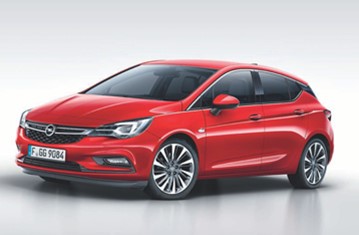
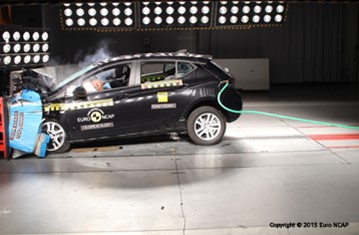
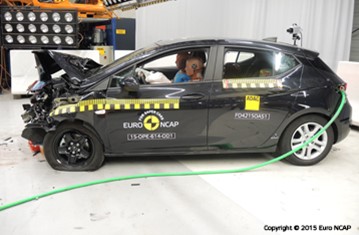
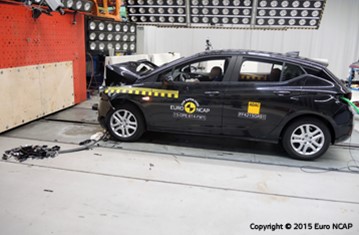
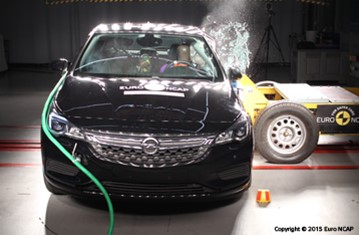
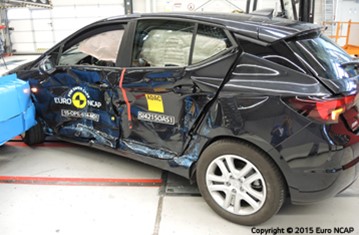
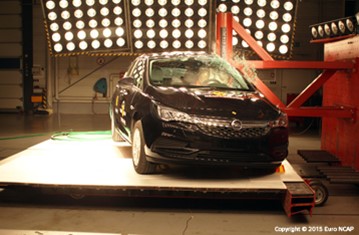
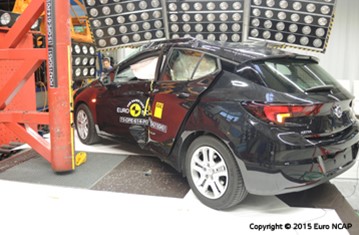



The passenger compartment of the Astra remained stable in the frontal offset test. Dummy readings indicated good protection of the knees and femurs of both the driver and passenger. Opel showed that a similar level of protection would be provided to occupants of different sizes and to those sat in different positions. In the full-width rigid barrier test, protection of the front and rear passenger dummies was good for all critical parts of the body except the chest, protection of which was adequate. Dummy readings indicated good protection of all critical body areas in both the side barrier impact and the more severe side pole test. However, in the side barrier impact, the rear door on the struck side became unlatched and the car was penalised. Opel are investigating the cause of this unlatching. The front seats and head restraints demonstrated good protection against whiplash injury in Euro NCAP's tests while a geometric assessment of the rear seats indicated the same level of protection to the occupants of those seats. The Astra has an autonomous emergency braking system which operates from the low, city speeds at which many whiplash injuries are caused. However, as the system is not standard equipment, its low-speed performance did not qualify for assessment.